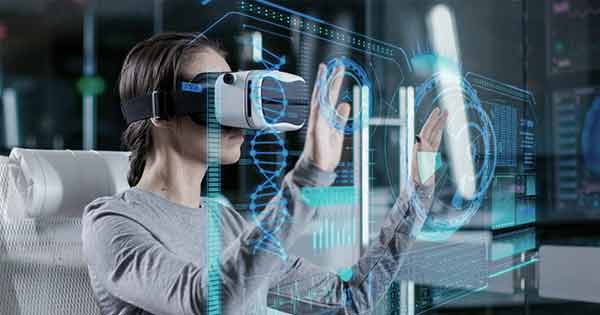Not so long ago, augmented and virtual reality technologies were curiosities. Today they are creating value in every phase of manufacturing.

by David Chen
Quality and efficiency are the lifeblood of any successful manufacturing operation. But the ongoing skills gap, labor shortages and high employee turnover are threatening these standards.
Fortunately, help is coming from a new and perhaps unlikely source: AR/VR technology. AR, or augmented reality, provides visual enhancements to objects or settings seen in the real world; virtual reality, on the other hand, is the “alternative universe” enjoyed by gamers and, increasingly, many others as well. Both are finding their way into applications from the factory floor to the training room, overcoming an increasing number of difficult manufacturing hurdles.
Google Maps AR, when paired with a smartphone camera, is a common example of AR. The technology superimposes directions or points of interest on a roadway or street scene, delivering instantly useful information. VR is typically experienced using goggles, headsets or heads-up displays that put the user’s eyes into the simulated environment, enabling the person to experience scenes and/or manipulate virtual objects.
AR/VR have uses in everything from entertainment, retail and fine arts to healthcare, education, even military applications. They’re now gaining value in industry as well. AR/VR can improve efficiency and ensure better quality products—but importantly, they can also compensate for the industrial skills gap by delivering fast, safe and robust training opportunities.
The benefits of AR/VR are generally found in three categories. In the training arena, VR allows learners to quickly adopt new skills in a safe, engaging setting. Traditional methods involve manuals, videos, classroom lectures and, if fortunate, hands-on lessons in simulators or the field. Complex and multi-step operations are hard to remember—and mistakes can be expensive, even dangerous.
AR/VR improves training by enabling hands-on experiences that risk neither raw materials, equipment nor personnel. Headsets and projectors give trainees real, immersive guidance on what to do, and what not to do. Unexpected scenarios can be posed at will and, because there is no incremental cost for repetition, skills are learned faster.
Inspection is another valuable application. AR/VR technology can guide workers through quality and safety checks, ensuring better product output. Using 3D imaging, for instance, it’s possible to build a VR “twin” of a wiring box in its real-world setting. If a malfunction occurs, even an untrained worker can inspect the box and compare it with its correct VR twin to quickly identify and repair the problem.
Production and assembly, the third segment, is enabled by AR projections onto subassemblies and kitting tables. Facilitated by overhead 3D cameras, the innovation can count parts, ensure proper attachments, and guide wiring. Workers receive instant feedback for each step, even in highly complicated assembly operations; they also move more efficiently and spend less time troubleshooting.
LightGuide, a Michigan-based AR solutions company, is one of the leaders in the industrial AR/VR movement. Its integrated systems are changing the way factories work in automotive, aerospace, electronics, food and beverage, medical and many other fields.
In one application, LightGuide’s AR empowers teams of workers to inspect and assemble automotive headliners using diagrams projected onto headliner blanks. Glue paths, harness routes, and adhesive tape placements are guided by projection, while 3D sensors confirm placement of each item. LightGuide has improved over 1,000 such processes, many with real-time analytics and digital traceability, for some of the world’s largest manufacturers.
VR is also finding its way into major technician training programs. Honeywell has been a leader in VR training; among its uses, it employs a VR training simulator to guide new personnel through various failure scenarios, generating skills retention twice as high as previous training methods. Through VR training, Honeywell is not only dealing with a high number of retiring plant personnel, but also making its training programs more engaging for younger generations of workers.
Deloitte, in its report on how to best use VR for training purposes, noted that the technique is especially effective for trainees who must confront phenomena in rare or dangerous situations that are difficult to observe. It cited the example of Linde, a large industrial gas supplier, who uses VR headsets to train its truck drivers in how to deal with anomalies when delivering cryogenic nitrogen or other gases that can freeze off fingers or be accidentally inhaled.
AR/VR is affordable to put into practice today. Manufacturers of all types and sizes are finding VR cost-effective for the two ends of the training spectrum: high-volume basic skills at one end, and fuzzy, specialized situations at the other, especially those requiring team coordination.
Large manufacturers can also easily justify the investment in AR on the production and operations side, to speed assembly and improve inspections. Regardless of size, it won’t be long before augmented and virtual solutions are common sights throughout manufacturing, solving staffing and production challenges that are very, very real indeed.

David Chen is co-founder and chief technical officer of Orbbec. A widely-published research engineer, Chen is an authority in digital imaging technology, optical measurement and imaging processing. He holds a PhD. in mechanical engineering from Oakland University.
In this episode, I sat down with Beejan Giga, Director | Partner and Caleb Emerson, Senior Results Manager at Carpedia International. We discussed the insights behind their recent Industry Today article, “Thinking Three Moves Ahead” and together we explored how manufacturers can plan more strategically, align with their suppliers, and build the operational discipline needed to support intentional, sustainable growth. It was a conversation packed with practical perspectives on navigating a fast-changing industry landscape.